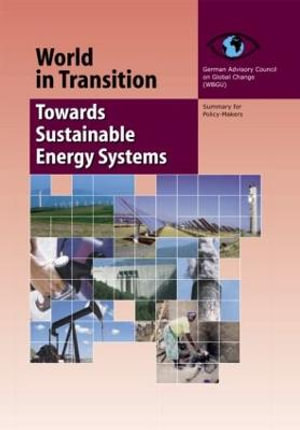
Instant online reading.
Don't wait for delivery!
World in Transition 3
Towards Sustainable Energy Systems
By: German Advisory Council On Global Change
Hardcover | 1 April 2004 | Edition Number 1
At a Glance
242 Pages
28.0 x 21.0 x 2.03
Hardcover
RRP $88.99
$77.25
13%OFF
or 4 interest-free payments of $19.31 with
orAvailable for Backorder. We will order this from our supplier however there isn't a current ETA.
'The publication of World in Transition: Towards Sustainable Energy Systems is timely indeed. The World Summit on Sustainable Development gave great prominence to this challenge, but failed to agree on a quantitative, time-bound target for the introduction of renewable energy sources. The German Advisory Council on Global Change (WBGU) has now produced a report with a global focus, which is essential in view of the global impacts of climate change. The report provides a convincing long-term analysis, which is also essential. Global energy policies have to take a long-term perspective, over the next 50 to 100 years, while providing concrete guidance for decision-makers to implement now.
There is an urgent need to secure energy supplies for the 2.4 billion people who still depend upon traditional biomass, while avoiding dangerous climatic changes. Our one world must close the gap between industrialized countries' surfeit and developing countries' poverty. Policies will need to consider both the broader environmental and specific climate constraints. I recommend this book very warmly to everyone concerned with global energy issues' Klaus Topfer, Executive Director, United Nations Environment Programme
World in Transition: Towards Sustainable Energy Systems underscores the urgent need to transform global energy systems so that the world's population has access to energy based on renewable sources. This is necessary to protect the global climate and to free those in developing countries trapped by energy poverty. Such an approach would also yield a peace dividend by reducing dependence upon regionally concentrated oil reserves.
The authors stress that such a reconfiguration of energy systems is both feasible and fundable if rapid and resolute action is taken in the coming two decades. To this end, they propose a roadmap with specific milestones, making this an indispensable contribution to the scientific and policy debates on these critical issues and essential reading for those engaged with them.
| Council Staff and Acknowledgement | p. V |
| Outline of Contents | p. VII |
| Contents | p. IX |
| Boxes | p. XV |
| Tables | p. XVI |
| Figures | p. XVIII |
| Acronyms and Abbreviations | p. XX |
| Summary for policymakers | p. 1 |
| Introduction | p. 11 |
| Social and economic energy system linkages | p. 13 |
| Introduction | p. 13 |
| The global setting | p. 13 |
| Rising energy and carbon productivity--trends up to 2020 | p. 13 |
| Energy use by sector | p. 14 |
| Lifestyles and energy consumption | p. 16 |
| Energy in industrialized countries | p. 17 |
| Energy supply structures | p. 17 |
| Principles and objectives of energy policy | p. 19 |
| Liberalization of markets for grid-based energy supply | p. 20 |
| Renewable energies in industrialized countries | p. 21 |
| Energy in developing and newly industrializing countries | p. 22 |
| Energy supply structures | p. 22 |
| Trends in energy demand by sector | p. 24 |
| Energy in transition countries | p. 26 |
| Energy use | p. 26 |
| Trends in energy demand by sector | p. 27 |
| Subsidies as a cause of inefficient energy consumption | p. 27 |
| Privatization, liberalization and (re-)regulation of energy industries | p. 28 |
| Economic and geopolitical framework conditions | p. 29 |
| Globalization as a new framework condition for energy policy action | p. 29 |
| Geopolitics | p. 29 |
| The institutional foundation of global energy policy | p. 32 |
| Knowledge base | p. 32 |
| Organization | p. 32 |
| Political declarations | p. 32 |
| International treaties | p. 34 |
| Operational and coordinating activities of the international organizations | p. 37 |
| Financing structure | p. 38 |
| Fragmented approaches to global energy policy | p. 41 |
| Interim summary: The starting point for global energy policy | p. 41 |
| Technologies and their sustainable potential | p. 43 |
| Introduction | p. 43 |
| Energy carriers | p. 43 |
| Fossil fuels | p. 43 |
| Potential | p. 43 |
| Technology/Conversion | p. 45 |
| Environmental and social impacts | p. 46 |
| Evaluation | p. 47 |
| Nuclear energy | p. 48 |
| Potential | p. 48 |
| Technology/Conversion | p. 49 |
| Environmental and social impacts | p. 50 |
| Evaluation | p. 51 |
| Hydropower | p. 52 |
| Global potential | p. 52 |
| Technology | p. 52 |
| Environmental and social impacts | p. 53 |
| Evaluation | p. 55 |
| Bioenergy | p. 56 |
| The potential of modern bioenergy | p. 56 |
| Environmental and social impacts of traditional biomass utilization in developing countries | p. 61 |
| Evaluation | p. 61 |
| Wind energy | p. 62 |
| Potential | p. 62 |
| Technology/Conversion | p. 63 |
| Environmental and social impacts | p. 64 |
| Evaluation | p. 65 |
| Solar energy | p. 65 |
| Potential | p. 65 |
| Technology/Conversion | p. 65 |
| Environmental and social impacts | p. 71 |
| Evaluation | p. 71 |
| Geothermal energy | p. 71 |
| Potential | p. 71 |
| Technology/Conversion | p. 72 |
| Environmental and social impacts | p. 73 |
| Evaluation | p. 73 |
| Other renewables | p. 73 |
| Cogeneration | p. 73 |
| Technology and efficiency potential | p. 73 |
| Range of applications | p. 75 |
| Economic performance | p. 75 |
| Evaluation | p. 76 |
| Energy distribution, transport and storage | p. 76 |
| The basic features of electricity supply structures | p. 76 |
| Supply strategies for microgrids | p. 76 |
| Supply strategies within electricity grids | p. 77 |
| Fluctuating demand in electricity grids | p. 77 |
| Fluctuating supply from renewable sources | p. 77 |
| Strategies for matching energy supply and demand | p. 78 |
| Hydrogen | p. 79 |
| The basics | p. 79 |
| Production | p. 79 |
| Storage and distribution | p. 81 |
| The use of hydrogen | p. 81 |
| Potential environmental damage from hydrogen | p. 82 |
| Electricity versus hydrogen: An assessment | p. 83 |
| Improvements in energy efficiency | p. 83 |
| Efficiency improvements in industry and business | p. 84 |
| Increased efficiency and solar energy utilization in buildings | p. 86 |
| Carbon sequestration | p. 88 |
| Technical carbon management | p. 88 |
| Potential for sequestration as biomass | p. 89 |
| Evaluation | p. 91 |
| Energy for transport | p. 91 |
| Technology options for road transport | p. 92 |
| Improvements in efficiency through information technology and spatial planning | p. 93 |
| Sustainability and external effects of increased transport energy demands | p. 93 |
| Evaluation | p. 94 |
| Summary and overall assessment | p. 94 |
| An exemplary path for the sustainable transformation of energy systems | p. 97 |
| Approach and methodology for deriving an exemplary transformation path | p. 97 |
| Energy scenarios for the 21st century | p. 98 |
| SRES scenarios as a starting point | p. 98 |
| Basic assumptions of the SRES scenarios | p. 100 |
| Emissions in the SRES scenarios | p. 101 |
| IPCC climate change mitigation scenarios ('post-SRES' scenarios) | p. 101 |
| Technology paths in the A1 world | p. 102 |
| Comparison of energy structures and climate change mitigation strategies | p. 102 |
| The role of carbon storage | p. 103 |
| Cost comparison | p. 103 |
| Environmental effects | p. 105 |
| Selection of a scenario for developing an exemplary path | p. 106 |
| Guard rails for energy system transformation | p. 107 |
| Ecological guard rails | p. 107 |
| Protection of the biosphere | p. 107 |
| Tolerable climate window | p. 108 |
| Sustainable land use | p. 113 |
| Biosphere conservation in rivers and their catchment areas | p. 115 |
| Marine ecosystem protection | p. 116 |
| Protection against atmospheric air pollution | p. 116 |
| Socio-economic guard rails | p. 117 |
| Human rights protection | p. 117 |
| Access to modern energy for everyone | p. 118 |
| Individual minimum requirement for modern energy | p. 118 |
| Limiting the proportion of income expended for energy | p. 120 |
| Minimum per capita level of economic development | p. 121 |
| Technology risks | p. 123 |
| Health impacts of energy use | p. 124 |
| Towards sustainable energy systems: An exemplary path | p. 126 |
| Approach and methodology | p. 126 |
| Modifying scenario A1T-450 to produce an exemplary path | p. 126 |
| The technology mix of the exemplary transformation path: An overview | p. 129 |
| Conclusion: The sustainable transformation of global energy systems can be done | p. 129 |
| Discussion of the exemplary path | p. 130 |
| The MIND model | p. 132 |
| The exemplary path: Relevance, uncertainties and costs | p. 136 |
| Uncertainties relating to permissible emissions | p. 136 |
| Costs of the exemplary transformation path, and financeability issues | p. 138 |
| Conclusions | p. 139 |
| The WBGU transformation strategy: Paths towards globally sustainable energy systems | p. 143 |
| Key elements of a transformation strategy | p. 143 |
| Actions recommended at the national level | p. 143 |
| Ecological financial reform | p. 144 |
| Internalizing the external costs of fossil and nuclear energy | p. 144 |
| Removing subsidies on fossil and nuclear energy | p. 146 |
| Conclusion | p. 147 |
| Promotion | p. 147 |
| Promoting renewable energy | p. 147 |
| Promoting fossil energy with lower emissions | p. 152 |
| Promoting efficiency in the provision, distribution and use of energy | p. 152 |
| Conclusion | p. 156 |
| Modern forms of energy and more efficient energy use in developing, transition and newly industrializing countries | p. 157 |
| The basic concept | p. 157 |
| Practical steps on the supply side | p. 157 |
| Practical steps on the demand side | p. 160 |
| Conclusion | p. 163 |
| Related measures in other fields of policy | p. 163 |
| Climate policy | p. 163 |
| Transport and regional development | p. 164 |
| Agriculture | p. 165 |
| Conclusion | p. 166 |
| Actions recommended at the global level | p. 166 |
| Expansion of international structures for research and advice in the energy sphere | p. 167 |
| Institutionalizing global energy policy | p. 168 |
| The functions of international institutions | p. 169 |
| Developing a World Energy Charter | p. 169 |
| Towards an International Sustainable Energy Agency | p. 170 |
| Funding global energy system transformation | p. 174 |
| Principles for equitable and efficient funding of global energy policy | p. 174 |
| Provision of new and additional funding | p. 175 |
| Use of resources for energy system transformation by international financial institutions | p. 180 |
| Directing international climate protection policy towards energy system transformation | p. 182 |
| Coordinating international economic and trade policy with sustainable energy policy objectives | p. 183 |
| Conclusion of a Multilateral Energy Subsidization Agreement | p. 183 |
| Transformation measures within the GATT/WTO framework | p. 185 |
| Preferential agreements in the energy sector | p. 186 |
| Technology transfer and the TRIPS Agreement | p. 186 |
| Liberalizing the world energy products market? | p. 188 |
| Rights and duties of direct investors | p. 190 |
| Phasing out nuclear energy | p. 191 |
| Development cooperation: Shaping energy system transformation through global governance | p. 192 |
| Launching 'best practice' pilot projects with a global impact | p. 194 |
| Research for energy system transformation | p. 197 |
| Systems analysis | p. 197 |
| Social sciences | p. 199 |
| Technology research and development | p. 202 |
| Technologies for supplying energy from renewable sources | p. 202 |
| System technology for sustainable energy supply | p. 204 |
| Development of techniques for more efficient energy use | p. 205 |
| Milestones on the WBGU transformation roadmap: Policy objectives, time frames and activities | p. 207 |
| From vision to implementation: Using the opportunities of the next 10-20 years | p. 207 |
| Protecting natural life-support systems | p. 207 |
| Reducing greenhouse gas emissions drastically | p. 207 |
| Improving energy productivity | p. 209 |
| Expanding renewables substantially | p. 210 |
| Phasing out nuclear power | p. 211 |
| Eradicating energy poverty worldwide | p. 211 |
| Aiming towards minimum levels of supply worldwide | p. 211 |
| Focussing international cooperation on sustainable development | p. 212 |
| Strengthening the capabilities of developing countries | p. 212 |
| Combining regulatory and private-sector elements | p. 213 |
| Mobilizing financial resources for the global transformation of energy systems | p. 213 |
| Using model projects for strategic leverage, and forging energy partnerships | p. 214 |
| Advancing research and development | p. 215 |
| Drawing together and strengthening global energy policy institutions | p. 215 |
| Negotiating a World Energy Charter and establishing coordinating bodies | p. 215 |
| Enhancing policy advice at the international level | p. 216 |
| Conclusion: Political action is needed now | p. 216 |
| References | p. 217 |
| Glossary | p. 231 |
| Index | p. 238 |
| Table of Contents provided by Ingram. All Rights Reserved. |
ISBN: 9781853838828
ISBN-10: 1853838829
Series: World in Transition
Published: 1st April 2004
Format: Hardcover
Language: English
Number of Pages: 242
Audience: Professional and Scholarly
Publisher: Taylor & Francis Ltd
Country of Publication: GB
Edition Number: 1
Dimensions (cm): 28.0 x 21.0 x 2.03
Weight (kg): 0.75
Shipping
| Standard Shipping | Express Shipping | |
|---|---|---|
| Metro postcodes: | $9.99 | $14.95 |
| Regional postcodes: | $9.99 | $14.95 |
| Rural postcodes: | $9.99 | $14.95 |
How to return your order
At Booktopia, we offer hassle-free returns in accordance with our returns policy. If you wish to return an item, please get in touch with Booktopia Customer Care.
Additional postage charges may be applicable.
Defective items
If there is a problem with any of the items received for your order then the Booktopia Customer Care team is ready to assist you.
For more info please visit our Help Centre.
You Can Find This Book In
This product is categorised by
- Non-FictionEarth Sciences, Geography, Environment, PlanningThe EnvironmentConservation of The Environment
- Non-FictionEngineering & TechnologyEnvironmental Science
- Non-FictionEngineering & TechnologyEnergy Technology & EngineeringAlternative & Renewable Energy Sources & Technology
- Non-FictionEarth Sciences, Geography, Environment, PlanningThe EnvironmentSustainability
- Non-FictionEarth Sciences, Geography, Environment, PlanningThe EnvironmentEnvironmental Management























